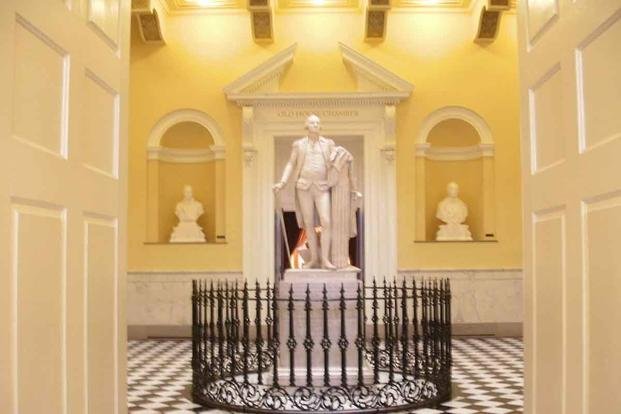Outside the National Gallery in London sits the strangest statue in Trafalgar Square, or maybe all of England. It's not bizarre because of its design or composition, but instead for whom the statue honors.
It is a replica, one of 25 or more, spread around the world. But it seems strange only in London, considering who it is and where the statue is placed.
It's a statue of George Washington, onetime citizen of Great Britain, father of the United States and rebellious colonial. In a square that marks one of Britain's greatest victories stands a reminder of one of its greatest defeats.
Washington's statue is not only there, but it's resplendent with symbols of authority, like the 13 wooden rods on which he leans (also a symbol of the 13 colonies). It's just hanging out in a square owned by the crown -- and built on soil shipped in from the state of Virginia.

The statue was presented to the British as a gift in 1921, when relations between the United States and the United Kingdom were much, much better than they had been in 1783. It's an exact replica of an original statue commissioned by Thomas Jefferson, which can still be seen in the Virginia State Capitol building in Richmond.
In fact, 25 casts of the statue have been made and spread all over the world, from the Washington Monument in Washington, D.C., to Lima, Peru and, of course, London's Trafalgar Square.
Because legend has it that George Washington once swore he would never set foot on British soil ever again, the erectors of the Trafalgar Square statue laid it on a foundation of Virginia soil to ensure that Washington did not tell a lie.
But the idea that the commander in chief of the Continental Army is somehow unwelcome in London is the real fiction. Washington was actually well-respected by the British people -- and by one very important British person in particular.
According to author and researcher Edward J. Larson, no less than King George III himself, whose land forces Washington spent seven years evading and killing, came to admire and respect the American leader.
That respect came after the American colonies were granted independence, and Washington, the head of the Continental Army, ceded his power and resigned rather than take the country by force. The king called Washington "the greatest man of the age."
The British prime minister at the time of American independence, William Petty, 1st Marquess of Lansdowne, even commissioned a life-size portrait of the first president during Washington's last year in office.
That portrait has become one of the most iconic of our first president. A copy was hung in the East Room of the White House at the end of John Adams' presidency, where it remains today. The original is owned by the U.S. National Portrait Gallery.
Lansdowne called Washington "the Greatest Man Living."
Washington is one of six American presidents who have statues or memorials in London. The others are Presidents Abraham Lincoln, Franklin D. Roosevelt, Dwight D. Eisenhower, John F. Kennedy and Ronald Reagan.
-- Blake Stilwell can be reached at blake.stilwell@military.com. He can also be found on Twitter @blakestilwell or on Facebook.
Want to Learn More About Military Life?
Whether you're thinking of joining the military, looking for post-military careers or keeping up with military life and benefits, Military.com has you covered. Subscribe to Military.com to have military news, updates and resources delivered directly to your inbox.
















